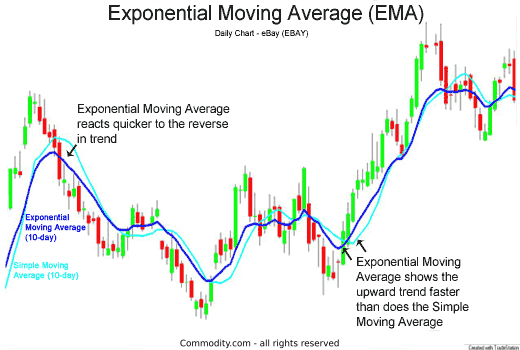The Exponential Moving Average (EMA) weighs current prices more heavily than past prices. This gives the Exponential Moving Average the advantage of being quicker to respond to price fluctuations than a Simple Moving Average; however, that can also be viewed as a disadvantage because the EMA is more prone to whipsaws (i.e. false signals).
Exponential Moving Average Formula
Exponential moving averages are recommended as the most reliable of the basic moving average types. They provide an element of weighting, with each preceding day given progressively less weighting. Exponential smoothing avoids the problem encountered with simple moving averages, where the average has a tendency to “bark twice”: once at the start of the moving average period and again in the opposite direction, at the end of the period. Exponential moving average slope is also easier to determine: the slope is always down when price closes below the moving average and always up when price is above.
To calculate an exponential moving average (EMA):
- Take today’s price multiplied by an EMA%.
- Add this to yesterday’s EMA multiplied by (1 – EMA%).
If we recalculate the earlier table we see that the exponential moving average presents a far smoother trend:
| Day | 1 | 2 | 3 | 4 | 5 | 6 | 7 | 8 | 9 |
| Price ($) | 16 | 17 | 17 | 10 | 17 | 18 | 17 | 17 | 17 |
| 33.3% (or 1/3) EMA | 16.3 | 16.5 | 14.4 | 15.2 | 16.2 | 16.4 | 16.6 | 16.8 |
Exponential Moving Average Percentage
EMA% is the weighting attached to the current days value:
- 50% would be used for a 3-day exponential moving average;
- 10% is used for a 19-day exponential moving average; and
- 1% is used for a 199-day exponential moving average.
To convert a selected time period to an EMA% use this formula:
EMA% = 2/(n + 1) where n is the number of days
Example: The EMA% for 5 days is 2/(5 days +1) = 33.3%
Incredible Charts performs this calculation automatically when you select an EMA time period.
The chart below of eBay (EBAY) stock shows the difference between a 10-day Exponential Moving Average (EMA) and the 10-day regular Simple Moving Average (SMA):

The main thing to notice is how much quicker the EMA responds to price reversals; whereas the SMA lags during periods of reversal.
The chart below of the Nasdaq 100 exchange traded fund (QQQQ) shows the difference between moving average crossovers (see: Moving Average Crossovers) possible buy and sell signals with a EMA and a SMA:

As the chart above of the QQQQ’s illustrates, even though EMA’s are quicker to respond to price movement, EMA’s are not necessarily faster to give possible buy and sell signals when using moving average crossovers.
Also note that the concept illustrated in the chart above with Exponential Moving Average crossovers is the concept behind the popular Moving Average Convergence Divergence (MACD) indicator; (see: MACD).
Since Exponential Moving Averages weigh current prices more heavily than past prices, the EMA is viewed by many traders as superior to the Simple Moving Average;
however, every trader should weigh the pros and the cons of the EMA and decide in which manner they will be using moving averages.
Nevertheless, Moving Averages remain the most popular technical analysis indicator out on the market today.
Read more at: https://commodity.com/technical-analysis/ma-exponential/